
Leucopogon verticillatus, commonly known as tassel flower, is a species of flowering plant in the heath family Ericaceae and is endemic to the southwest of Western Australia. It is an erect, bamboo-like shrub with broadly lance-shaped leaves and pink, tube-shaped flowers crowded along spikes in leaf axils and on the ends of branches.

Prostanthera rhombea, commonly known as sparkling mint-bush, is a plant in the family Lamiaceae and is endemic to disjunct areas of south-eastern Australia. It is an openly-branched shrub with strongly aromatic branches, circular to heart-shaped leaves and mauve or bluish flowers.
Dendrobium rigidum, commonly known as the smooth tongue orchid or smooth tick orchid, is a species of orchid native to tropical North Queensland and to New Guinea. It is an epiphytic or lithophytic orchid with wiry, hanging stems, fleshy, dark green leaves and flowering stems with between two and seven crowded, cream-coloured, star-shaped flowers often with pink or red on the back. It grows on trees, shrubs and rocks in a paperbark swamps and rainforest.

Styphelia pendula is a species of flowering plant in the heath family Ericaceae and is endemic to the south-west of Western Australia. It is an erect, straggling shrub with oblong leaves and white, tube-shaped flowers that are bearded inside.

Leucopogon gracilis is a species of flowering plant in the heath family Ericaceae and is endemic to the south of Western Australia. It is a spindly shrub with wiry branchlets, linear to lance-shaped leaves, and dense spikes of white or pinkish flowers.

Prostanthera caerulea, commonly known as lilac mint bush, is a species of flowering plant that is endemic to eastern Australia. It is an erect shrub with narrow egg-shaped leaves that have toothed edges, and white to bluish mauve flowers arranged on the ends of branchlets.

Prostanthera prunelloides is a species of flowering plant in the family Lamiaceae and is endemic to eastern New South Wales. It is a shrub with four-ridged branches, egg-shaped to round leaves and white or pale mauve flowers.

Prostanthera violacea, commonly known as violet mint-bush, is a species of flowering plant in the family Lamiaceae and is endemic to south-eastern New South Wales. It is a slender, strongly aromatic shrub with densely hairy branches, more or less round leaves with the edges rolled under and mauve to bluish flowers often with white tips.
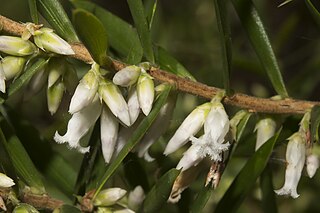
Styphelia propinqua is a species of flowering plant in the heath family Ericaceae and is endemic to the south-west of Western Australia. It is an erect, rigid shrub with linear leaves and white tube-shaped flowers that are bearded inside.

Epacris mucronulata is a species of flowering plant in the heath family Ericaceae and is endemic to Tasmania. It is an erect shrub with softly-hairy young branches, lance-shaped leaves, and cylindrical white flowers in small groups at the ends of the branches.

Leucopogon assimilis is a species of flowering plant in the family Ericaceae and is endemic to the south of Western Australia. It is an erect, slender shrub with linear or lance-shaped leaves and pink to white, tube-shaped flowers.
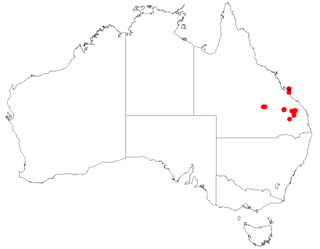
Styphelia flexifolia is a species of flowering plant in the family Ericaceae and is endemic to south-east Queensland. It is a rigid shrub with many softly-hairy branchlets, crowded, sharply-pointed linear to lance-shaped leaves, and small, white, bell-shaped flowers that are bearded inside.

Leucopogon glabellus is a species of flowering plant in the family Ericaceae and is endemic to the south-west of Western Australia. It is an erect, glabrous shrub with slender branchlets, heart-shaped to lance-shaped leaves, and cylindrical spikes of white flowers.
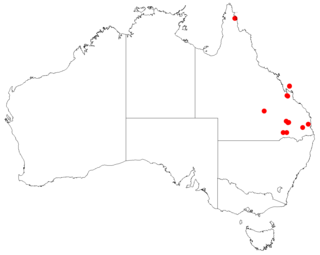
Styphelia imbricata is a species of flowering plant in the family Ericaceae and is endemic to south-east Queensland. It is an erect shrub with glabrous branches, crowded, often overlapping, egg-shaped leaves, and white, bell-shaped flowers that are bearded inside.

Leucopogon interruptus is a species of flowering plant in the family Ericaceae and is endemic to the southwest of Western Australia. It is a spreading, glabrous shrub with oval to oblong leaves crowded at the ends of branches, and many small, white, tube-shaped flowers that are bearded inside.
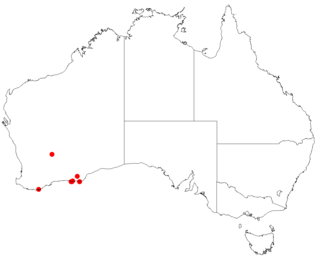
Styphelia multiflora is a species of flowering plant in the family Ericaceae and is endemic to the southwest of Western Australia. It is a rigid shrub with crowded, sharply-pointed, linear to lance-shaped leaves, and white, tube-shaped flowers usually in groups in leaf axils.

Leucopogon reflexus, commonly known as heart-leaf beard-heath, is a species of flowering plant in the heath family Ericaceae and is endemic to the south-west of Western Australia. It is an erect shrub with small, usually downturned leaves and short, dense spikes of tube-shaped, white flowers.

Styphelia rotundifolia is a species of flowering plant in the heath family Ericaceae and is endemic to the south of Western Australia. It is an erect, bushy shrub with round or egg-shaped leaves, the narrower end towards the base, and white, tube-shaped flowers arranged in leaf axils in groups of 2 or 3.
Styphelia striata is a species of flowering plant in the heath family Ericaceae and is endemic to the south of Western Australia. It is an erect to spreading shrub with egg-shaped leaves and white, tube-shaped flowers arranged in dense spikes on the ends of branches and in upper leaf axils.
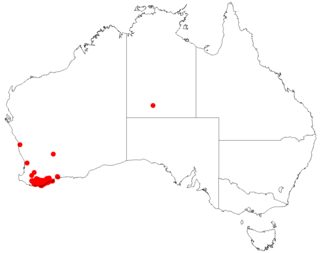
Leucopogon tamariscinus is a species of flowering plant in the heath family Ericaceae and is endemic to the south of Western Australia. It is an erect shrub with egg-shaped or lance-shaped leaves and white, tube-shaped flowers arranged in dense spikes on the ends of branches.



















